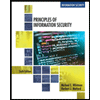
Concept explainers
The premise that our society is different from what it would have been without the computer revolution is generally accepted. Is our society better than it would have been without the revolution? Is our society worse? Would your answer differ if your position within society were different?
Explanation of Solution
Impact of Computer Revolution on the society:
“Yes”, the society is better than it would have been without the computer revolution.
Explanation:
The computer is the decisive technology of the Information Age where every nook and corner of the world is connected with World Wide Web.
Our current society is a product of the digital revolution. Out of the most accomplishments by the human kind, the microcomputer is the foremost that changed the way we communicate, connect or do business.
- The earliest of computer were developed to help in calculation and to aid the industrialists or engineers to aid in solving the problems which were difficult to accomplish by a single person.
- Now, the life can’t be imagined without the computers since every appliance we hold has microcomputer in it ranging from air conditioner, washing machine to television or mobile phones.
- The world has been reduced to a small village with the advent of computer revolution. The business is solely dependent on the internet. E-commerce has revolutionized the way industries are doing business. The banking system relies hugely on the internet.
With the help of computers, the knowledge can accessed within seconds. The learning curve of human beings has increased sharply due to knowledge sharing across the borders with the advent of internet.
Disadvantages of computer revolution:
- Although the impact of the computer has been ubiquitous, the technology has produced some threats like e-waste, over exploitation of the earth resources to construct computers and smartphones.
- The human interaction has reduced due to over relying on the computers. There is danger of leakage of personal or private information and the crimes like cybercrimes, online theft possess a threat to humans.
Apart from the negatives, it is up to human beings to use the technology to our benefit. Everything comes with advantages and disadvantages. The humans are intelligent enough to choose and decide how to make constructive use of the computer revolution.
“No”, the answer wouldn’t be different because the computer revolution has impacted the entire mankind more or less.
Reason:
The computer revolution has made the life easier because of automatic and smart control of life saving instruments, the instant wireless communication and better design of the home. It has helped to save time and tedious work.
Want to see more full solutions like this?
Chapter 0 Solutions
Computer Science: An Overview (12th Edition)
Additional Engineering Textbook Solutions
INTERNATIONAL EDITION---Engineering Mechanics: Statics, 14th edition (SI unit)
Thinking Like an Engineer: An Active Learning Approach (4th Edition)
BASIC BIOMECHANICS
Thermodynamics: An Engineering Approach
Database Concepts (8th Edition)
Java: An Introduction to Problem Solving and Programming (8th Edition)
- Please solve and answer the questions correctly please. Thank you!!arrow_forwardConsidering the TM example of binary sum ( see attached)do the step-by-step of execution for the binary numbers 1101 and 11. Feel free to use the Formal Language Editor Tool to execute it; Write it down the current state of the tape (including the head position) and indicate the current state of the TM at each step.arrow_forwardI need help on inculding additonal code where I can can do the opposite code of MatLab, where the function of t that I enter becomes the result of F(t), in other words, turning the time-domain f(t) into the frequency-domain function F(s):arrow_forward
 Principles of Information Systems (MindTap Course...Computer ScienceISBN:9781285867168Author:Ralph Stair, George ReynoldsPublisher:Cengage Learning
Principles of Information Systems (MindTap Course...Computer ScienceISBN:9781285867168Author:Ralph Stair, George ReynoldsPublisher:Cengage Learning Principles of Information Systems (MindTap Course...Computer ScienceISBN:9781305971776Author:Ralph Stair, George ReynoldsPublisher:Cengage Learning
Principles of Information Systems (MindTap Course...Computer ScienceISBN:9781305971776Author:Ralph Stair, George ReynoldsPublisher:Cengage Learning Fundamentals of Information SystemsComputer ScienceISBN:9781337097536Author:Ralph Stair, George ReynoldsPublisher:Cengage Learning
Fundamentals of Information SystemsComputer ScienceISBN:9781337097536Author:Ralph Stair, George ReynoldsPublisher:Cengage Learning Systems ArchitectureComputer ScienceISBN:9781305080195Author:Stephen D. BurdPublisher:Cengage Learning
Systems ArchitectureComputer ScienceISBN:9781305080195Author:Stephen D. BurdPublisher:Cengage Learning Fundamentals of Information SystemsComputer ScienceISBN:9781305082168Author:Ralph Stair, George ReynoldsPublisher:Cengage Learning
Fundamentals of Information SystemsComputer ScienceISBN:9781305082168Author:Ralph Stair, George ReynoldsPublisher:Cengage Learning Principles of Information Security (MindTap Cours...Computer ScienceISBN:9781337102063Author:Michael E. Whitman, Herbert J. MattordPublisher:Cengage Learning
Principles of Information Security (MindTap Cours...Computer ScienceISBN:9781337102063Author:Michael E. Whitman, Herbert J. MattordPublisher:Cengage Learning





